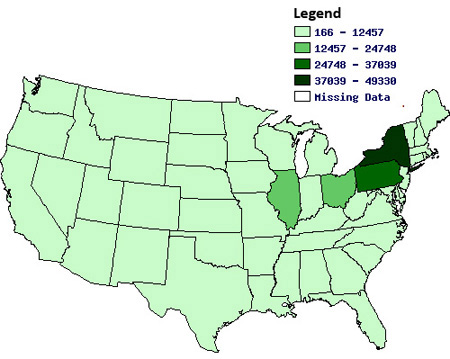
1. What U.S. census data does this map portray?
a. The 1930 relative concentration of "totally unemployed persons registered" in each state.
b. The 1870 relative amount of "total capital invested (in dollars) in manufacturing" in each state.
c. The 1920 relative concentration of "manufacturing establishments" in each state.
d. The 1950 relative concentration of "employed females" in each state.
By 1920, industry had established itself as a fixture of the American economy and way of life, though its hubs remained in the Mid-Atlantic. New York continued to be a center of industry, and Illinois, with the continuing rise of Chicago as an urban industrial center, had become one, as well.
2. On May 4, 1886, a peaceful workers' rally in Chicago's Haymarket Square ended in death and confusion when a dynamite bomb was thrown into a line of approaching police officers. The Haymarket Affair received nationwide media attention and the trials of the alleged guilty parties went all the way up to the U.S. Supreme Court. Four of the accused were hung and a fifth committed suicide.
What reform was the rally supporting?
a. The removal of hazardous parts-manufacturing machinery from a McCormick Harvesting Machine Company plant.
b. The passing of a minimum-wage law in the state of Illinois.
c. The paying of compensation to workers who suffered debilitating injuries from repetitive factory work.
d. The institution of the eight-hour workday.
The speakers at the Haymarket Affair supported strikers who had engaged in a May 1 nationwide walkout to support an eight-hour workday. On May 3, the first workday after the walkout, police killed two workers outside a McCormick plant during a confrontation between scabs (temporary workers hired to replace strikers) and strikers. This event provided an impetus for the Haymarket rally.
3. On February 6, 1919, more than 60,000 Seattle workers refused to work, marking the high point of a series of strikes and unrest that started in January 1919. The first labor action to effectively shut down an entire city, this strike hoped to secure what result?
a. The reinstatement of workers ousted by returning soldiers.
b. A pay raise for the city's shipyard workers.
c. The cessation of all U.S. hostilities against the Bolshevik Red Army in Russia and of any support for forces opposing the Red Army.
d. A stop to the installation of new machinery that would reduce the work force necessary in the shipyards.
During World War I, the government imposed wage controls, keeping the wages of Seattle shipyard workers down even as the shipyards expanded through war production contracts. Following the war, the workers expected a raise in their wages; when denied, approximately 25,000 members of the Metal Trades Council union alliance went on strike. A general citywide strike followed, with about 35,000 other workers striking in support of the shipyard protest. The strike officially ended on February 11—though not before touching off a widespread "Red Scare."
4. On December 30, 1936, the workers at Flint, Michigan's General Motors automobile plant began a six-week long strike to press for better working conditions. Organized by the United Auto Workers, the strike used what relatively unusual technique to make its point?
a. Strikers not only stopped working during the strike, but left town entirely, taking their families with them.
b. Strikers remained entirely silent during the strike.
c. Strikers, instead of picketing outside of the factory, occupied the factory, preventing upper management and law enforcement from entering.
d. Strikers sabotaged the factory's power supply, re-sabotaging it whenever plant management repaired it.
Known as the Flint Sit-down Strike, this strike used techniques later adapted by the civil rights movement. On December 30, workers sat down at their places and refused to leave the factory for six weeks. Provided food and supplies by supporters, the workers repelled attempts by the police to drive them out and even initiated the surprise takeover of another plant in the last two weeks of the strike.
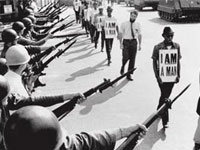
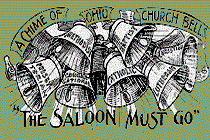
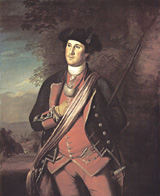
 Roosevelt spoke these words on March 4, 1933, in his First Inaugural Address— which also included his famous phrase "the only thing we have to fear is fear itself." In this speech, FDR first assured the American people that he had faith that the Constitution and current understandings of constitutionally-acceptable presidential power were sufficient to overcome the crisis posed by the Great Depression. He then went on to note that, if necessary for the good of the country, he would ask Congress for executive power equivalent to that granted in wartime.
Roosevelt spoke these words on March 4, 1933, in his First Inaugural Address— which also included his famous phrase "the only thing we have to fear is fear itself." In this speech, FDR first assured the American people that he had faith that the Constitution and current understandings of constitutionally-acceptable presidential power were sufficient to overcome the crisis posed by the Great Depression. He then went on to note that, if necessary for the good of the country, he would ask Congress for executive power equivalent to that granted in wartime. In his book Democracy in America, French thinker, writer, and politician Alexis de Tocqueville (1805-1859), considers the strengths and weakness of the American federal system of government as it was in the early 1830s, when he visited the young country on a 9-month tour. This passage comes from chapter 8 of the book's first volume: "On the Federal Constitution." Subheading "The Federal Constitution, Part V," "Why the Federal System is Not Adapted to All Peoples" looks at the uniqueness of the Constitution and of the expectations it sets out for the people putting it into practice.
In his book Democracy in America, French thinker, writer, and politician Alexis de Tocqueville (1805-1859), considers the strengths and weakness of the American federal system of government as it was in the early 1830s, when he visited the young country on a 9-month tour. This passage comes from chapter 8 of the book's first volume: "On the Federal Constitution." Subheading "The Federal Constitution, Part V," "Why the Federal System is Not Adapted to All Peoples" looks at the uniqueness of the Constitution and of the expectations it sets out for the people putting it into practice.  Fiery abolitionist William Lloyd Garrison (1805-1879) included this condemnation of the Constitution in the December 29, 1832, issue of his abolitionist newspaper The Liberator. The article in which it appeared, titled "On the Constitution and the Union," denounced the Constitution for allowing slavery to exist in the U.S., calling it a document "dripping" "with human blood."
Fiery abolitionist William Lloyd Garrison (1805-1879) included this condemnation of the Constitution in the December 29, 1832, issue of his abolitionist newspaper The Liberator. The article in which it appeared, titled "On the Constitution and the Union," denounced the Constitution for allowing slavery to exist in the U.S., calling it a document "dripping" "with human blood."  Woodrow Wilson included these words in his 1913 book The New Freedom: A Call for the Emancipation of the Generous Energies of a People, which laid out many of the views on which he had campaigned for the presidency. Writing in 1885, in his earlier book Congressional Government, Wilson saw many problems in the United States' established form of government, arguing that the Founders' system of checks and balances obscured responsibility more than it ensured balance. Wilson saw the Constitution as a product of a certain time and place, with questionable relevance to the present day.
Woodrow Wilson included these words in his 1913 book The New Freedom: A Call for the Emancipation of the Generous Energies of a People, which laid out many of the views on which he had campaigned for the presidency. Writing in 1885, in his earlier book Congressional Government, Wilson saw many problems in the United States' established form of government, arguing that the Founders' system of checks and balances obscured responsibility more than it ensured balance. Wilson saw the Constitution as a product of a certain time and place, with questionable relevance to the present day. 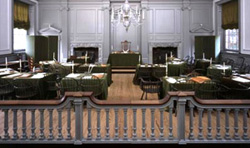

 The tune that would later become "John Brown's Body" developed in the religious camp meetings of the Second Great Awakening (a period of widespread evangelical religious revival, from the early to mid-1800s). Though it existed in various forms for at least several years beforehand, the music first appeared in print in choral books in 1858. Religious lyrics accompanied these versions—and included the "glory, glory, hallelujah" chorus that would remain in "John Brown's Body."
The tune that would later become "John Brown's Body" developed in the religious camp meetings of the Second Great Awakening (a period of widespread evangelical religious revival, from the early to mid-1800s). Though it existed in various forms for at least several years beforehand, the music first appeared in print in choral books in 1858. Religious lyrics accompanied these versions—and included the "glory, glory, hallelujah" chorus that would remain in "John Brown's Body."  According to the most common "origin story," the tune to "John Brown's Body" gained its most famous lyrics—"John Brown's body lies a-mouldering in the grave"—in 1859, some time after the execution of John Brown, the abolitionist who led an antislavery raid on Harper's Ferry, VA, and was subsequently hanged. However, these lyrics were not, originally, about that John Brown. Instead, they referred to a Massachusetts Union soldier, whose fellow soldiers improvised the song from the original camp-meeting tune and religious lyrics to tease him. The song gained verses and lyrics and spread, to be heard by others who assumed "John Brown" was John Brown the abolitionist. Later lyrics, like (d) above, worked from this assumption.
According to the most common "origin story," the tune to "John Brown's Body" gained its most famous lyrics—"John Brown's body lies a-mouldering in the grave"—in 1859, some time after the execution of John Brown, the abolitionist who led an antislavery raid on Harper's Ferry, VA, and was subsequently hanged. However, these lyrics were not, originally, about that John Brown. Instead, they referred to a Massachusetts Union soldier, whose fellow soldiers improvised the song from the original camp-meeting tune and religious lyrics to tease him. The song gained verses and lyrics and spread, to be heard by others who assumed "John Brown" was John Brown the abolitionist. Later lyrics, like (d) above, worked from this assumption. William Weston Patton (pictured here), abolitionist and president of Howard University, heard the song "John Brown's Body" in one of its early versions and wrote a more polished, elaborate set of lyrics for the tune. These lyrics changed the song from being about a John Brown (sometimes the abolitionist and sometimes not) to the John Brown, explicitly telling the story of Brown's execution and memorializing him as a martyr to the abolitionist cause.
William Weston Patton (pictured here), abolitionist and president of Howard University, heard the song "John Brown's Body" in one of its early versions and wrote a more polished, elaborate set of lyrics for the tune. These lyrics changed the song from being about a John Brown (sometimes the abolitionist and sometimes not) to the John Brown, explicitly telling the story of Brown's execution and memorializing him as a martyr to the abolitionist cause. Abolitionist Julia Ward Howe (pictured here) first heard "John Brown's Body" sung by soldiers during an 1861 troop review in Washington, DC. The tune struck her, but the lyrics, in one of their early forms referring to John Brown of the Massachusetts militia, did not. Shortly afterwards, she woke in a DC hotel and composed the words of a poem set to the tune of "John Brown's Body" while lying in bed. In 1862, the Atlantic Monthly published her new lyrics—a paean to the Union Army—to be sung along with the music that had inspired her to write it.
Abolitionist Julia Ward Howe (pictured here) first heard "John Brown's Body" sung by soldiers during an 1861 troop review in Washington, DC. The tune struck her, but the lyrics, in one of their early forms referring to John Brown of the Massachusetts militia, did not. Shortly afterwards, she woke in a DC hotel and composed the words of a poem set to the tune of "John Brown's Body" while lying in bed. In 1862, the Atlantic Monthly published her new lyrics—a paean to the Union Army—to be sung along with the music that had inspired her to write it.



 The map of the 1920 concentration of manufacturing establishments was generated by the University of Virginia Library's
The map of the 1920 concentration of manufacturing establishments was generated by the University of Virginia Library's 